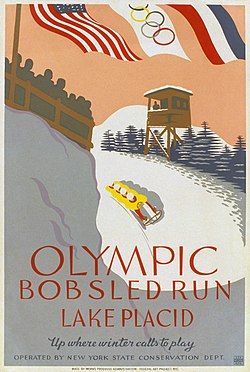This article needs additional citations for verification .(December 2014) |
 | |
| Location | Lake Placid, New York, United States |
|---|---|
| Nations | 17 |
| Athletes | 252 (231 men, 21 women) |
| Events | 14 in 4 sports (7 disciplines) |
| Opening | February 4, 1932 |
| Closing | February 13, 1932 |
| Opened by | |
| Stadium | Olympic Stadium Lake Placid |
Winter Summer | |
The 1932 Winter Olympics, officially known as the III Olympic Winter Games and commonly known as Lake Placid 1932, were a winter multi-sport event in the United States, held in Lake Placid, New York, United States. The games opened on February 4 and closed on February 13. It was the first time the Winter Games were held outside of Europe and the first of four Winter Olympics held in the United States; Lake Placid hosted again in 1980. [1]
Contents
- Highlights
- Events
- Demonstration sports
- Venues
- Participating nations
- Number of athletes by National Olympic Committees
- Medal count
- Podium sweeps
- See also
- References
- External links
The games were awarded to Lake Placid in part by the efforts of Godfrey Dewey, head of the Lake Placid Club and son of Melvil Dewey, inventor of the Dewey Decimal System. [2] California also had a bid for the 1932 Winter Games. William May Garland, president of the California X Olympiad Association, wanted the games to take place in Wrightwood and Big Pines, California. The world's largest ski jump at the time was constructed in Big Pines for the event, [3] but the games were ultimately awarded to Lake Placid.
The practice of awarding Olympic medals at podium ceremonies was established at the 1932 Winter Olympics, based on pedestals used at the 1930 British Empire Games, as proposed by Melville Marks Robinson. [4]




